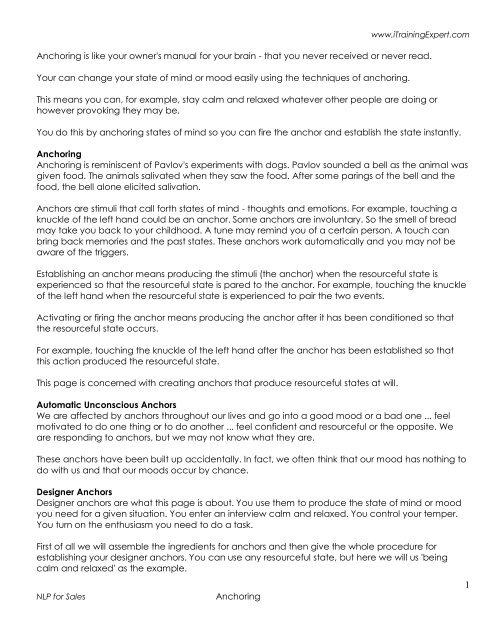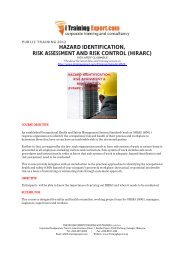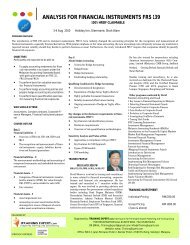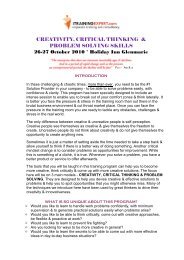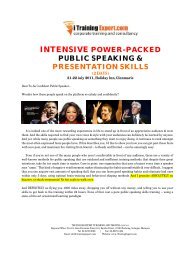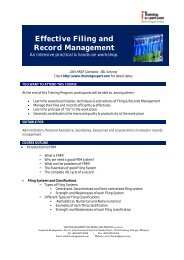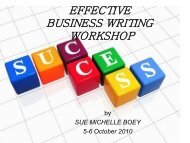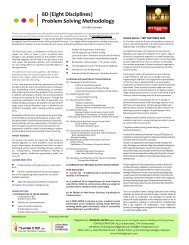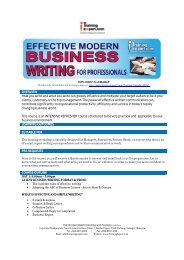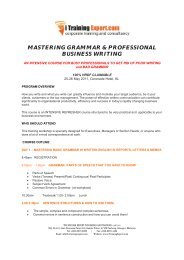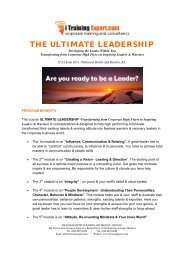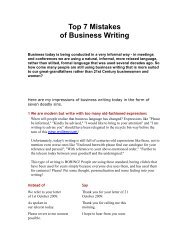(visual-auditory-kinesthetic) learning style indicators and free self-test
(visual-auditory-kinesthetic) learning style indicators and free self-test
(visual-auditory-kinesthetic) learning style indicators and free self-test
Create successful ePaper yourself
Turn your PDF publications into a flip-book with our unique Google optimized e-Paper software.
www.iTrainingExpert.comAnchoring is like your owner's manual for your brain - that you never received or never read.Your can change your state of mind or mood easily using the techniques of anchoring.This means you can, for example, stay calm <strong>and</strong> relaxed whatever other people are doing orhowever provoking they may be.You do this by anchoring states of mind so you can fire the anchor <strong>and</strong> establish the state instantly.AnchoringAnchoring is reminiscent of Pavlov's experiments with dogs. Pavlov sounded a bell as the animal wasgiven food. The animals salivated when they saw the food. After some parings of the bell <strong>and</strong> thefood, the bell alone elicited salivation.Anchors are stimuli that call forth states of mind - thoughts <strong>and</strong> emotions. For example, touching aknuckle of the left h<strong>and</strong> could be an anchor. Some anchors are involuntary. So the smell of breadmay take you back to your childhood. A tune may remind you of a certain person. A touch canbring back memories <strong>and</strong> the past states. These anchors work automatically <strong>and</strong> you may not beaware of the triggers.Establishing an anchor means producing the stimuli (the anchor) when the resourceful state isexperienced so that the resourceful state is pared to the anchor. For example, touching the knuckleof the left h<strong>and</strong> when the resourceful state is experienced to pair the two events.Activating or firing the anchor means producing the anchor after it has been conditioned so thatthe resourceful state occurs.For example, touching the knuckle of the left h<strong>and</strong> after the anchor has been established so thatthis action produced the resourceful state.This page is concerned with creating anchors that produce resourceful states at will.Automatic Unconscious AnchorsWe are affected by anchors throughout our lives <strong>and</strong> go into a good mood or a bad one ... feelmotivated to do one thing or to do another ... feel confident <strong>and</strong> resourceful or the opposite. Weare responding to anchors, but we may not know what they are.These anchors have been built up accidentally. In fact, we often think that our mood has nothing todo with us <strong>and</strong> that our moods occur by chance.Designer AnchorsDesigner anchors are what this page is about. You use them to produce the state of mind or moodyou need for a given situation. You enter an interview calm <strong>and</strong> relaxed. You control your temper.You turn on the enthusiasm you need to do a task.First of all we will assemble the ingredients for anchors <strong>and</strong> then give the whole procedure forestablishing your designer anchors. You can use any resourceful state, but here we will us 'beingcalm <strong>and</strong> relaxed' as the example.NLP for SalesAnchoring1
www.iTrainingExpert.comAlthough we have dealt with the subject of establishing anchors in some depth in this page, it isactually extremely easy to establish them!The Resource StateYou have all the resources you require to achieve whatever goal you want. This is a presupposition.You can recall any memories when you have experienced the required state. Recall them vividly<strong>and</strong> you recall the state. So you can recall any memories of being extremely calm <strong>and</strong> relaxed toget the resource for your anchor.You might recall being calm <strong>and</strong> relaxed at work, for example, or from a time when you were athome or enjoying your leisure time.To vivify the memory use instructions as:Recall a time when you were calm <strong>and</strong> relaxed. As you go back to that time now step into yourbody <strong>and</strong> you are seeing now what you see in the memory, hearing now what you heard in thememory, <strong>and</strong> feeling now, what you feel in the memory.Even people who think they have no resourceful memory can find such a memory perhaps in adifferent context.I have never felt that way ...If you cannot recall a situation where you had the resource you want to anchor, you can get theresource by imagining your<strong>self</strong> in a situation where you had that resource.Everyone has the capacity to empathise with another. When listening to another you may haveexperienced the emotions <strong>and</strong> states that they felt when they had the experience.Types of AnchorsAnchors can be <strong>visual</strong>, <strong>auditory</strong> or <strong>kinesthetic</strong>.Visual AnchorsYou can use <strong>visual</strong> anchors to anchor the resourceful state. You can use external or internal anchors.For example, you could use a figure on a bracelet to anchor being calm <strong>and</strong> relaxed. The externalanchor always has to be there for you to use. You may find it relaxing <strong>and</strong> calming to view a certainl<strong>and</strong>scape, but unless you can carry it around with you, it is of limited value. You can however usean internal image of the l<strong>and</strong>scape to anchor your resourceful feeling.Most <strong>visual</strong> designer anchors are internal. Some examples of <strong>visual</strong>anchors are:• Symbols. For example, you could use a circle as a symbol forbeing calm <strong>and</strong> relaxed <strong>and</strong> anchor this to your state.• People, such as a trusted friend or mentor ... or even a personfrom history or current affairs.• Various objects <strong>and</strong> l<strong>and</strong>scapes can be used as anchors forbeing calm <strong>and</strong> relaxed. For example, you could imagine:o A teddy bearo A flowerNLP for SalesAnchoring2
www.iTrainingExpert.comAuditory AnchorsYou can use a sound as an anchor. Like the <strong>visual</strong> anchors, sounds can be internal or external. Manypeople have used whistling as an anchor - they whistle when they feel afraid!You can use an internal voice as an anchor. For example, you could anchor the phrase 'Calm <strong>and</strong>Relaxed'.Kinesthetic Anchors.Examples of <strong>kinesthetic</strong> anchors are:• Imagining a comforting h<strong>and</strong> on your shoulder• Making a circle with the second finger <strong>and</strong> the thumb• Touching your<strong>self</strong> on the h<strong>and</strong> or other unobtrusive place. You can choose a point <strong>and</strong> treat it likean acupressure point - pressing on it to fire the required state.NLP for SalesAnchoring3
www.iTrainingExpert.comVisual, Kinesthetic <strong>and</strong> Auditory AnchorsYou can use a combination of anchors such as seeing a certain symbol in your mind's eye. Hearingsomething said - for example, Calm <strong>and</strong> Relaxed. And Press your h<strong>and</strong> in a special place.Installing Anchors1. Decide on the state you want to anchor. For example being calm <strong>and</strong> relaxed.2. Choose an anchor (or anchors) that you wish to trigger the resourceful state.3. Recall a memory or imagine a situation where you can experience the state. So recall or imaginea time when you experienced the state.4. Active the anchor or anchors when the experience is vivid <strong>and</strong> you are in the desired state.5. Release the anchors when the experience begins to fade.If you keep applying the anchor whenthe experience is fading, then you will anchor a drop in calmness <strong>and</strong> relaxation!6. Do something else - open your eyes ... count down from 10 to break state <strong>and</strong> distract your<strong>self</strong>.7. Repeat the steps several times, each time making the memory more vivid. This is not actuallyrequired when the anchor is established at the high point of the experience. However, you canstrengthen the anchor by establishing it at the high point of several such experiences.8. Apply the anchor <strong>and</strong> check that the required state occurs.9.Future pace the situation where you want to experience the desired state. Fire the anchor tocheck that it creates a sufficiently resourced state..10.Check the anchor the next day to ensure it is a permanent anchor.NLP for SalesAnchoring4
www.iTrainingExpert.comTips• The anchor (or anchors) should be fired in exactly the same way every time you link them to theresourcefulexperience.• Anchor at the high point of the experience containing the resourceful state.• If you do not experience the state when future pacing <strong>and</strong> especially if you experience anxiety,then stopapplying the anchor. (You will anchor the negative state!)• There is a knowingness which makes anchoring work that is established by the unconscious mind.• You can strengthen the anchor by repeating the above process over several days.If you are in a situation where you experience the desired state in reality, then you can reestablishthe anchor to that situation.References:http://www.trans4mind.com/personal_development/mindMastery/anchoring.htmNLP for SalesAnchoring5


